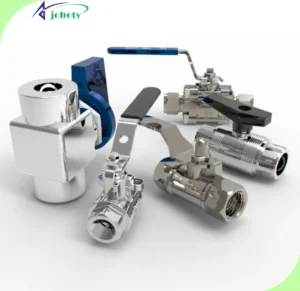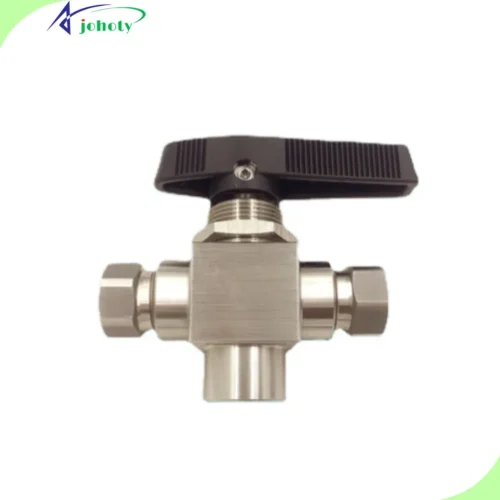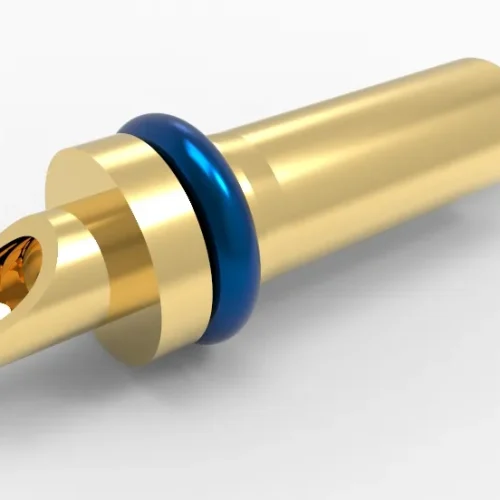How do Ball Valves Work? Know ball valves in aerospace fluid propulsion, hydraulic, and pneumatic systems, controlling fuel and oxidizer flow to ensure engine function. Vital for gas supply and cooling systems, crucial for aircraft operation. Let’s delve into ball valve principles and their aerospace significance.
How do ball valves work, ball valves are a crucial fluid control device commonly used in the aerospace industry. They employ a spherical valve body to control fluid flow by rotating for opening and closing. With a simple and reliable design, ball valves typically consist of a valve body, stem, seat, and seals.
During operation, when the valve is closed, the ball rotates to seal against the seat, blocking fluid passage. Conversely, when the valve is unsealed, the ball pivots away from its seating, granting fluid the liberty to move through unimpeded. Ball valves offer the advantage of rapid opening and closing. Thus finding extensive use in fluid control scenarios requiring a swift response in the aerospace domain. Such as fuel pipelines, hydraulic systems, and lubrication circuits. Their corrosion resistance and high-pressure containment capability make them absolutely essential in aerospace engineering.

Introduction: How do Ball Valves Work?
- In modern aerospace engineering, the importance of fluid control technology is self-evident. And when it comes to core components within fluid control systems, ball valves play a crucial role in the aerospace sector.
- This article delves deeply into the operational principles of ball valves and their critical significance in aerospace fluid control.
- As a simple yet efficient fluid control device, ball valves boast a unique design. It enables reliable operation even in high-pressure, high-temperature, and extreme environments.
In aerospace engineering:
- Ball valves are employed to regulate fluid flow in hydraulic and propulsion systems. Serve as indispensable components in critical areas, such as aircraft engines and spacecraft propulsion systems.
- By thoroughly examining the operational principles of ball valves. We can better grasp their application in aerospace fluid control and explore future trends in this field.
- Our goal in crafting this article is to offer you a detailed and expertly crafted guide. It is by elucidating the structure, sealing mechanisms, and application case studies of ball valves in fluid control systems.
- It seeks to empower readers to deepen their understanding and utilization of ball valve technology. Thereby offering crucial support for the successful realization of aerospace engineering endeavors.
Basic Concepts and Structure: How do Ball Valves Work?
Basic Concepts:
- Within a ball valve, fluid flow is managed through the rotation of a ball within one or more apertures or pathways. Ball valves are known for their rapid opening and closing, excellent sealing properties, and resistance to high pressure and corrosion.
- Hence, they are widely utilized in various industrial systems, especially in aerospace systems that demand high-performance fluid control.
Structural Components:
Ball valves primarily consist of the following parts:
a. Valve Body:
- The valve body is the main component of the ball valve, typically made of metal for high strength and corrosion resistance. It contains fluid passages through which the ball rotates to control fluid flow.
b. Valve Cover:
- Attach the valve cover to the top of the valve body to secure the valve stem and sealing device. The standard practice is to fashion it from the identical material as the valve’s body to ensure overall sealing performance.
c. Valve Stem:
- The valve stem is the most crucial component of the ball valve, typically a spherical metal or plastic piece made of wear-resistant materials.
- The valve stem rotates or moves to open and close fluid passages, thereby controlling fluid flow.
d. Sealing Device:
- The sealing device of a ball valve typically comprises sealing rings, sealing surfaces, and other components. It is to ensure sealing performance between the valve body and cover, as well as between the valve stem and body.
- High-quality sealing devices effectively prevent fluid leakage, ensuring the reliability and safety of the ball valve.
e. Actuator (Optional):
- Some ball valves are equipped with actuators such as handles, gears, and pneumatic, or electric actuators for convenient operation.
- Actuators enable remote or automatic control of the ball valve’s opening and closing, enhancing its usability and flexibility.
Types:
Based on differences in structure and operating principles, ball valves can be classified into various types:
- Floating Ball Valves
- Trunnion Ball Valves
- V-port Ball Valves
- Three-way Ball Valves
- Four-way Ball Valves
Each type of ball valve has specific application scenarios and advantages. Allowing for the selection of the most suitable type based on specific requirements.
Operating Principles: How do Ball Valves Work?
Open State:
- When the ball valve is in the open state, the user rotates the valve stem to a certain angle. This design enables fluid to move unimpeded through the channels housed within the valve body.
- At this point, the holes in the valve stem align with the channels in the valve body. Creating a clear passage for fluid to flow smoothly.
Closed State:
- When the ball valve needs to be closed, rotate the valve stem to another angle. Causing its holes to no longer align with the channels in the valve body, thereby blocking fluid flow.
- When closed, the valve stem forms a watertight seal with the valve body, guaranteeing no seepage.
Sealing Mechanism:
- Ensure the sealing performance of the ball valve by the contact surface. The formation of this seal involves the alignment of the valve stem with the valve body. Along with the engagement of the sealing rings.
- When the valve stem rotates to the closed position, the sealing rings are pressured. This guarantees a precise alignment between the ball valve’s body and stem. Establishing a reliable barrier to ensure there’s no leakage of fluid.
Operating Modes:
- Ball valves can be operated manually, pneumatically, or electrically. Manual ball valves are operated via handles or gears, and pneumatic ball valves are controlled by pneumatic actuators.
- While electric ball valves are operated using electric actuators. Different operating modes can meet various control requirements and work environments.
Application Scope:
- Due to its simple and reliable operating principles, ball valves are widely used in various industrial fields. In aerospace systems that require high-performance fluid control.
- Its characteristics include rapid opening and closing, along with excellent sealing performance. This makes it an indispensable fluid control device in aerospace engineering.
The Importance and Application Cases: How do Ball Valves Work?
Propulsion Systems:
- In aerospace propulsion systems, ball valves control the flow of liquids, such as fuel and oxidizers. For example, in rocket engines, ball valves are utilized to regulate the flow of fuel and oxidizers.
- Ensuring that fuel is supplied as needed before and after ignition, thus achieving precise control of the propulsion system.
Hydraulic Systems
- Ball valves are also widely used in the hydraulic systems of aerospace vehicles. They finely tune the movement and speed of liquids within the hydraulic system, ensuring precise control.
- Ensuring timely and accurate responses to the aircraft’s operational commands. This guarantees the aircraft’s stability and safety, crucial for smooth operations.
Aircraft Engines
- Employ ball valves in aircraft engines to control the flow of liquids, such as fuel and lubricants.
- For instance, in turbojet engines, ball valves regulate the supply of fuel and lubricants. Ensuring stable and efficient engine operation while reducing fuel consumption and emissions.
Cabin Doors and Cabin Door Sealing Systems
- In aircraft cabin doors and sealing systems, ball valves control the opening and closing of airtight doors. The rapid opening and closing speed of ball valves, along with their reliable sealing performance.
- Ensure to quickly seal cabin doors to prevent pressure loss. By doing so, effectively guaranteeing the safety of the aircraft and its passengers, paramount in importance.
Air Handling Systems
- Employ ball valves in the air handling systems of aerospace vehicles. They regulate the airflow and pressure in the air handling system. Ensure the air quality and comfort inside the spacecraft, meeting the needs of passengers and crew members.
Parachute Systems
- In the parachute systems of spacecraft, ball valves are instrumental in controlling the activation and stowing of parachutes.
- Ball valves can rapidly and accurately respond to commands, ensuring that parachutes can be deployed promptly and safely. Provide essential protection for the landing of the spacecraft.
Technical Innovation and Development Trends: How do Ball Valves Work?
Material Innovation:
- High-Temperature and High-Pressure Materials: As the demand for high-temperature and high-pressure environments in aerospace engineering increases. Ball valve materials need to possess higher heat and pressure resistance.
- Therefore, developing new high-temperature alloy materials has become an important technological trend. This can ensure the reliable operation of ball valves in extreme conditions.
- Lightweight High-Strength Materials: To reduce the weight of aerospace systems, ball valve materials are also evolving towards lightweight and high-strength materials.
- Such as titanium alloys, carbon fiber composites, etc., the goal is to elevate system performance and drive efficiency improvements.
Design Innovation:
- Fluid Dynamics Optimization Design: By numerical simulation and experimental verification, optimizing the internal flow structure and resistance characteristics of ball valves.
- It is to reduce pressure loss and improve flow control accuracy and response speed.
- Compact Design: To adapt to the compact space of aerospace systems, ball valve designs tend to be more compact and lightweight.
- At the same time, sustains top-tier performance standards and ensures unwavering reliability.
Sealing Technology Innovation:
- Adaptive Sealing Technology: Developing new sealing materials and technologies that can adaptively adjust sealing performance according to the working environment.
- The aim is to guarantee the constancy and dependability of ball valves under different operating conditions.
- Ultra-Low Leakage Design: To meet the stringent requirements of aerospace systems for ultra-low leakage rates, developing new sealing structures and technologies.
- To minimize leakage rates, ensuring system safety and environmental friendliness.
Intelligence and Automation:
- Intelligent Control Systems: Integrating sensors, controllers, and communication technologies to achieve intelligent monitoring, diagnosis, and remote control of ball valves.
- The objective is to elevate the automation and intelligence quotient of systems.
- Predictive Maintenance Technology: Utilizing big data analysis and artificial intelligence technology. The goal is to accomplish real-time monitoring and predictive analysis of ball valve performance and health status.
- Detect potential faults in advance for maintenance, decrease system downtime, and lower maintenance costs.
Environmental Protection and Sustainable Development:
- Low-Emission Materials and Processes: Adopting eco-friendly materials and production processes to reduce environmental pollution and energy consumption during the manufacturing of ball valves.
- Promote sustainable development in the aerospace field.
- Recycling and Regeneration Technology: Developing recyclable and regenerative ball valve materials and components to reduce resource consumption and waste emissions.
- Alleviate environmental pressure, and achieve sustainable resource utilization.
Overview of Aerospace Flow Control Technology: How do Ball Valves Work?
Importance of Flow Control Technology:
- Fluid control in aerospace systems involves the precise control and adjustment of parameters. It involves tracking the flow rates, pressures, and temperatures of different liquid and gas media.
- The accuracy and stability of fluid control directly impact the performance, safety, and economy of aerospace vehicles.
Application Scope of Flow Control Technology:
- Propulsion Systems: Controlling the supply of fuel and oxidizers, regulating the magnitude and direction of thrust.
- Hydraulic Systems: Controlling the flow of hydraulic oil to drive the movement of aircraft control surfaces, landing gear, and other components.
- Power Systems: Controlling the supply of propellants, such as liquid oxygen and liquid hydrogen to achieve propulsion and adjustment of power systems.
Key Elements of Flow Control Technology:
- High-precision Control Valves: Including ball valves, butterfly valves, throttle valves, etc., for accurately regulating fluid flow and pressure.
- Precision Sensors: Used for real-time monitoring of fluid parameters, such as pressure, temperature, flow rate, etc. Provide accurate feedback information to the system.
- Intelligent Control Systems: By integrating controllers, actuators, and human-machine interfaces, achieve intelligent monitoring and adjustment of fluid control processes.
Development Trends of Flow Control Technology:
- Intelligence and Automation: Integrating sensors and intelligent control algorithms to realize intelligent monitoring and automatic adjustment of fluid control systems. This involves boosting the system’s automation capabilities and operational effectiveness.
- Precision and Efficiency: Through optimized design and advanced manufacturing processes, improving the accuracy and response speed of control valves. To achieve precise adjustment and efficient operation of fluid control.
- Promoting sustainable progress and upholding environmental integrity: Implementing green materials and production methods to diminish energy consumption and waste emissions associated with the system. Promote sustainable development in the aerospace field.
Integration of Ball Valves with Aerospace Flow Control Technology: How do Ball Valves Work?
Applications in Propulsion Systems:
- Liquid Propellant Control: Ball valves control the supply of liquid propellants, such as liquid oxygen and liquid hydrogen. This ensures the propulsion systems maintain stability and reliability.
- Aerospace vehicles require precise adjustment of propellant flow and pressure under various conditions to achieve accurate control of thrust.
- Fuel Supply Control: Ball valves can also control the supply of fuels, such as kerosene and methane. Regulating fuel flow and mixture ratio during combustion to ensure combustion efficiency and safe operation of propulsion systems.
Usages in Hydraulic Systems:
- Flight Control Surface Operation: Ball valves control the flow of hydraulic oil, driving the movement of aircraft control surfaces, landing gear, and other components. It is to achieve precise operation of flight control surfaces.
- This involves fine-tuning the pressure and flow within the hydraulic system. Ball valves ensure the aircraft’s stability and maneuverability are upheld throughout takeoff, flight, and landing is essential.
- Brake System Control: Ball valves also control the flow of hydraulic oil in brake systems, regulating the braking force and duration. The objective is to secure both the safety and smoothness of aircraft landings.
Deployments in Power Systems:
- Aircraft Engine Fuel Supply: Ball valves control the fuel supply in aircraft engine fuel systems, regulating fuel flow and pressure. To ensure normal combustion and thrust output of the engine.
- Spacecraft Propellant Supply: Ball valves also control the supply of propellants in spacecraft power systems, regulating propellant flow and pressure. To achieve attitude adjustment and orbit control of spacecraft.
Intelligence and Automation:
- Intelligent Flow Control Systems: Integrate intelligent sensors and controllers. Real-time monitoring and intelligent adjustment of ball valve operation and fluid control processes are achieved. The goal is to elevate both the automation level and stability of the system.
- Remote Control and Monitoring: Through remote communication technology, can realize remote control and monitoring of ball valves and fluid control systems. Provide convenience for ground operation and maintenance of aerospace vehicles.
Conclusion: How do Ball Valves Work?
In aerospace fluid control systems, the ball valve is a crucial element, serving an irreplaceable function. Through in-depth exploration of the working principles, application cases, and integration with aerospace flow control technology, we can see:
Critical Role:
- Ball valves play a critical role in the aerospace field, involving propulsion systems, hydraulic systems, power systems, and more. Have a direct influence on the aircraft’s performance, safety, and reliability.
Technological Innovation:
- With the continuous development of aerospace technology, ball valve technology is also continuously innovating and progressing. Continuous improvements in materials, design, sealing technology, etc.
- This feature enables ball valves to perform reliably even in conditions of high temperature, high pressure, and extreme environments..
Intelligence and Automation:
- Intelligence and automation are important trends in the development of ball valve technology. By integrating intelligent sensors and control systems, can achieve intelligent monitoring, diagnosis, and remote control of ball valves. Improving the efficiency and safety of the system.













